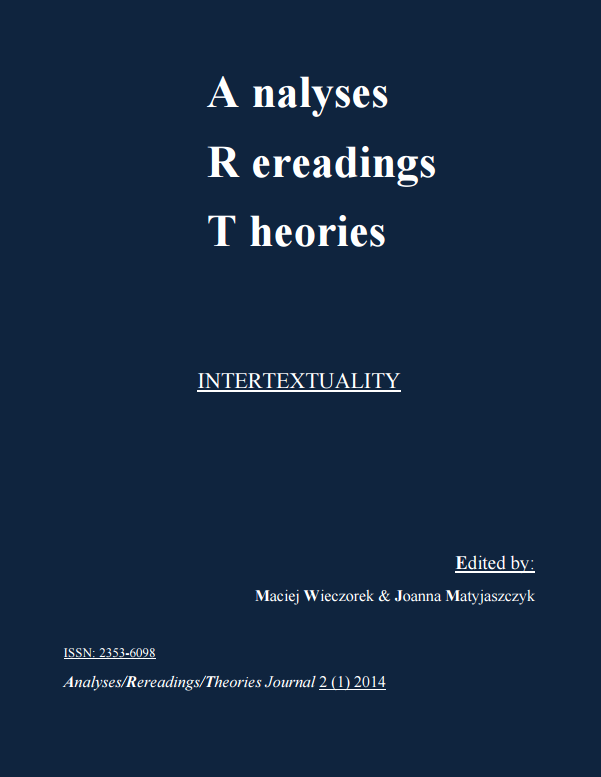Subverting the Gaze, Seducing with the Bible: A Study of Oscar Wilde's Salomé
DOI:
https://doi.org/10.18778/2353-6098.2.02Keywords:
Oscar Wilde, Bible, Salomé, male gazeAbstract
The present article engages with the eponymous character of Oscar Wilde’s “Salomé” and focuses on her subversion of the patriarchal rules, and on her attempts at seducing the prophet Jokanaan. Wilde’s “Salomé” becomes “an erotic symbol of daring, transgression, and perversity” (Sloan 112). She wants to look at Jokanaan, as well as to be touched by him and openly states her great desire for him, using the imagery taken from the biblical “Song of Songs” to express her passion. Moreover, the Princess skillfully adopts and reverses the male gaze to manipulate others and go beyond the patriarchal constraints at Herod’s court. She becomes aware that the only way to reach her goals is to look actively and evade being a mere object of the male gaze. The article shows that the imagery employed in the eponymous character’s speeches contributes to her portrayal as a seductress, also accentuating her rebellion, and analyzes how the Princess transgresses the patriarchal constraints through appropriating the male gaze.
References
Bach, Alice. Women, Seduction, and Betrayal in Biblical Narrative. New York: Cambridge UP, 1997. Print.
Google Scholar
Bucknell, Brad. “On ‘Seeing’ Salome.” ELH 60.2 (1993): 503-26. Web. 16 Nov. 2012.
Google Scholar
Chaudhuri, Shohini. “The Male Gaze.” Feminist Film Theorists Laura Mulvey, Kaja Silverman, Teresa de Lauretis, Barbara Creed. Ed. Shohini Chaudhuri. London: Taylor & Francis e- Library, 2006. 31-44.
Google Scholar
Finney, Gail. “Demythologizing the Femme Fatale: Wilde’s Salomé.” The Routledge Reader in Gender and Performance. 1998. Ed. Lizbeth Goodman and Jane de Gay. London: Taylor & Francis e-Library, 2002. 182-86.
Google Scholar
Garland-Thomson, Rosemarie. Staring: How We Look. New York: Oxford UP, 2009. Print.
Google Scholar
The Holy Bible: King James Version. Cambridge: Cambridge UP, 1995. Print.
Google Scholar
Im, Yeeyon. “Oscar Wilde’s Salomé: Disorienting Orientalism.” Comparative Drama. 45.4 (2011): 361-80. Web. 14 Dec. 2012.
Google Scholar
DOI: https://doi.org/10.1353/cdr.2011.0033
Janicka-Świderska, Irena. “Dance in Modernist Drama: Oscar Wilde and William Butler Yeats.” Dance in Drama. Łódź: Wydawnictwo Uniwersytetu Łódzkiego, 1992. 117-57. Print.
Google Scholar
Marcovitch, Heather. “The Princess, Persona, and Subjective Desire: A Reading of Oscar Wilde’s Salome.” PLL 40.1 (2004): 88-101. Web. 22 Dec. 2012.
Google Scholar
Mulvey, Laura. “Visual Pleasure and Narrative Cinema.” Film Theory and Criticism Introductory Readings. 4th ed. Ed Gerald Mast, Marshall Cohen and Leo Braudy. New York: Oxford UP, 1992. 746-57.
Google Scholar
Pismo Święte Starego i Nowego Testamentu, Biblia Tysiąclecia. Ed. Kazimierz Dynarski SAC and Maria Przybył. Poznań: Pallottinum, 2005.
Google Scholar
Sloan, John. Oscar Wilde. New York: Oxford UP, 2003. Print.
Google Scholar
Tookey, Helen. “‘The Fiend that Smites with a Look’: The Monstrous/Menstruous Woman and the Danger of the Gaze in Oscar Wilde’s Salomé.” Literature & Theology 18.1 (2004): 23-37. Web. 16 Nov. 2012.
Google Scholar
DOI: https://doi.org/10.1093/litthe/18.1.23
Treat, Jay C. “Song of Songs: To the Reader.” A New English Translation of the Septuagint. Ed. Albert Pietersma and Benjamin G. Wright. Oxford: Oxford UP, 2007. 657-61. Electronic Edition of NETS. Web. 11 Feb. 2013.
Google Scholar
Wilde, Oscar. Salomé. The Collected Works of Oscar Wilde. Hertfordshire: Wordsworth, 1997. 717-42. Print.
Google Scholar
Downloads
Published
How to Cite
Issue
Section
License

This work is licensed under a Creative Commons Attribution-NonCommercial-NoDerivatives 3.0 Unported License.









